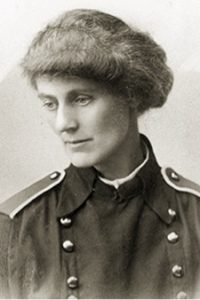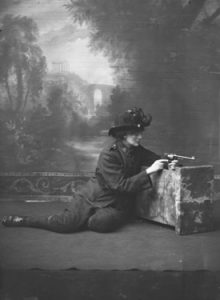Constance Markievicz (1868-1927)
“Remember no one has it in his power to make me unhappy”
Countess Constance Markievicz (1868-1927) was an Irish Sinn Féin and Fianna Fáil politician, nationalist, suffragette and socialist. She was the founding member of the Irish Citizen Army, took part in the Easter Rising in 1916, when Irish republicans attempted to end British rule and established an independent Irish Republic. On 28 December 1918, she was the first woman elected to the British House of Commons, though she did not take her seat along with the other Sinn Féin members out of protest. She also became the first woman to hold a cabinet position as Minister for Labour of the Irish Republic from 1919 to 1922.
Markievicz was born Constance Georgina Gore-Booth to Sir Henry Gore-Booth and Georgina, Lady Gore-Boot in 1868. Her father was a wealthy land owner in western Ireland. Despite her social background, Markievicz was always aware of class differences, following the model of her father who worked to maintain positive relationships with his tenants. Growing up, she was described as fearless, and full of artistic talent. As a young adult, she moved to Paris to study art, where she met the Polish-Russian Count and artist Casimir Markievicz (1874-1934), whom she married in 1900. They spent six months in Kiev before going back to Paris and then settling in Dublin, Ireland in 1901. In Dublin, the Markieviczs very quickly became involved in the lively literary, artistic, and political social life. It was during this time that Countess Markievicz’s political career began.
Markievicz became a very adamant Irish Nationalist. In 1908, she joined Sinn Féin and Inghinidhe na hÉireann (Daughters of Ireland), a revolutionary Irish women’s association. One year later, when the English Boy Scouts decided to extend to Ireland, Markievicz helped to found Fianna Éireann, a para-military nationalist scouting organization that instructed teenage boys in the use of firearms. The Fianna members were not allowed to join any English armed force.
In 1913, Markievicz’s husband moved back to Ukraine, because the couple had become estranged. In the same year she joined the socialist Irish Citizen Army, a small volunteer force formed in response to the lockout of 1913, to defend the striking and demonstrating Irish workers from the police. Markievicz recruited volunteers to peel potatoes in a basement while she and others worked on distributing the food. All the food was paid out of her own pocket. A friend described Constance’s involvement during the lockout by writing: “She espoused an unpopular cause, and braved conventions in her championship of the poor and lowly.” This statement, could be used to describe not just her attitude during the lockout, but her general attitude towards life, as she always stood by her ideals with a fierce determination. Due to her deep political and social involvement, the people of Dublin came to refer as the ‘The Countess’ or simply ‘Madame.’
As a member of the Irish Citizen Army, Markievicz took part in the Irish Easter Rising in April 1916, when the Irish Republic was declared. Violence quickly followed between the Irish Nationalists and the English Government. After a week of brutal fighting, the Irish Nationalist Army surrendered. The Countess was sentenced to death for her involvement in the rebellion, but her sentence was reduced to prison because of her gender. The conditions in prison were rough and took a toll on her health. Her sister petitioned for better conditions, with little effect. However, Markievicz consoled her “Don’t worry about me. Remember no one has it in his power to make me unhappy.” In July of 1917, she was offered amnesty and released from prison.
This was the first of many times that Markievicz would be imprisoned for her involvement in Irish uprising in the next years. In 1918, with World War I dragging on, England decided to force Irish men to join the British armed forces and attempted to extent the newly implemented universal conscription to Ireland. This enraged the nationalists, many were arrested for refusing to serve. Markievicz supported their fight and was soon arrested again and this time deported to England where she was put in Holloway Prison in London.
In the General Election of 1918, the first election for which women were allowed to vote in the United Kingdom, Markievicz was elected to the British House of Commons for St. Patrick’s Division of Dublin as the first woman. She was still in prison and no intention of accepting the seat. Together with the other elected Sinn Féin parliamentarians, she declined to protest against the English Ireland policy. Markievicz was released from Holloway in March of 1919 and could thus not participate at the first meeting of the First Dáil, the Parliament of the newly founded Irish Republic in Dublin, which had declared its independence from Britain on January 1919. The Irish republicans established a government, a court system and a police force and controlled Irish Republican Army that fought against British state forces in the Irish War of Independence that ended on 6 December 1921. The Irish-Anglo Treaty was narrowly approved by the Irish parliament on 7 January 1922. Markievicz served during this challenging time as Minister for Labour of the Irish Republic. She held this position from April 1919 to January 1922. Afterwards, she continued her work for worker’s rights and Irish nationalism, through publications and speeches until her death in 1927, due to illness.
The Countess was remembered by the people of Dublin for her gracious generosity, her fierce dedication to her cause, and her fearlessness. She never allowed her work for her own empowerment and the empowerment of others to be diminished on account of her gender. For these reasons, she deserves much respect and admiration.
Sophie Nachmann, Major in Computer Science, Minor in Women and Gender Studies, Class of 2021
Sources
Literature and Websites
- Arrington, Lauren. Revolutionary Lives: Constance and Casimir Markievicz. Princeton, NJ: Princeton University Press, 2016
- Eldridge, Alison. “Constance Markievicz: Anglo-Irish Countess and Political Activist.” Encyclopædia Britannica, at: https://www.britannica.com/biography/Constance-Markievicz (Accessed 25 April 2018)
- Markievicz, Constance de, Eva Gore-Booth, and Esther Roper. Prison Letters of Countess Markievicz (Constance Gore-Booth). Also Poems and Articles Relating to Easter Week by Eva Gore-Booth, and a Biographical Sketch by Esther Roper. London: Longmans, Green and Co., 1934.
- Quigley, Patrick. Sisters against the Empire: Countess Constance Markievicz and Eva Gore-Booth, 1916-1917. Dublin: Liffey Press, 2016.
Images




